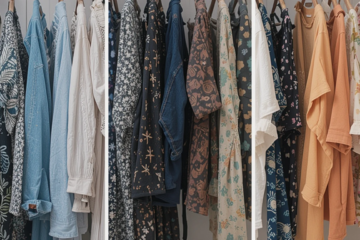Denim is one of the most iconic and versatile fabrics in fashion history. What began as durable workwear for laborers has evolved into a global wardrobe staple, embraced by people of all ages, genders, and styles. From its humble beginnings to its status as a cultural symbol, the history of denim is a fascinating journey. Let’s dive into how denim became the timeless fabric we know and love today.
The Origins of Denim
Denim’s story begins in the 19th century, when it was created as a sturdy fabric for workers. The word “denim” comes from “serge de Nîmes,” a fabric from Nîmes, France. However, it was in the United States that denim truly took off, thanks to its durability and practicality.
Key Milestones:
- 1873: Levi Strauss and Jacob Davis patented the first riveted denim jeans, designed for miners during the California Gold Rush.
- Early 1900s: Denim became synonymous with hard work, worn by farmers, railroad workers, and factory laborers.

Denim in the 20th Century: From Workwear to Pop Culture
The 20th century saw denim transition from practical workwear to a symbol of rebellion, youth culture, and fashion.
1950s: Denim became associated with rebellion, thanks to icons like James Dean in Rebel Without a Cause and Marlon Brando in The Wild One.
1960s-1970s: Denim was embraced by the counterculture movement, with bell-bottoms and embroidered jeans becoming popular.
1980s: Designer denim emerged, with brands like Calvin Klein and Guess turning jeans into a luxury item.
1990s: Denim became a grunge staple, with ripped jeans and oversized denim jackets defining the era.

Denim in the 21st Century: A Global Fashion Staple
Today, denim is a universal fabric, worn by people across the globe. It has evolved to include countless styles, washes, and fits, making it a versatile choice for any occasion.
Key Trends:
- Skinny Jeans: A 2000s staple that remains popular.
- Vintage and Distressed Denim: Embracing the worn-in, nostalgic look.
- Sustainable Denim: Eco-friendly production methods and recycled denim.
- Gender-Neutral Styles: Oversized fits and unisex designs.

The Cultural Impact of Denim
Denim is more than just fabric—it’s a cultural phenomenon. It has been a canvas for self-expression, a symbol of rebellion, and a tool for social change.
Examples:
- Music Icons: From Elvis Presley to Beyoncé, denim has been a staple in music fashion.
- Movies and TV: Denim has played a starring role in films like Grease and TV shows like Friends.
- Social Movements: Denim has been used to make statements, like the “Denim Day” campaign against sexual violence.

How to Style Denim Today
Denim’s versatility makes it a must-have in any wardrobe. Here are some tips for styling denim in 2023:
- Double Denim: Pair a denim jacket with jeans for a chic, coordinated look.
- Dress It Up: Wear a denim skirt or jeans with a blazer and heels for a polished outfit.
- Go Casual: Style distressed jeans with a graphic tee and sneakers for a laid-back vibe.
- Experiment with Washes: Mix light and dark denim for a modern twist.

The Future of Denim
As fashion evolves, so does denim. The future of denim lies in sustainability, innovation, and inclusivity. Brands are exploring eco-friendly production methods, recycled materials, and gender-neutral designs to meet the demands of conscious consumers.

Final Thoughts
From its origins as durable workwear to its status as a global fashion staple, denim has come a long way. Its ability to adapt to changing times and trends is a testament to its enduring appeal. Whether you’re rocking vintage jeans, a denim jacket, or a trendy denim dress, you’re part of a rich history that continues to shape the world of fashion. So, the next time you slip into your favorite pair of jeans, remember—you’re wearing a piece of history.



0 Comments